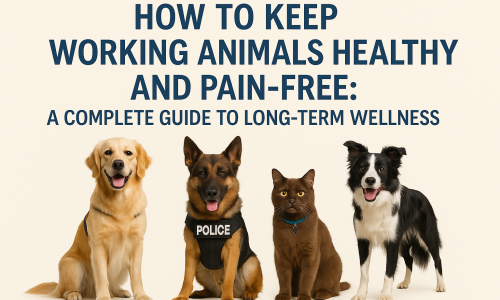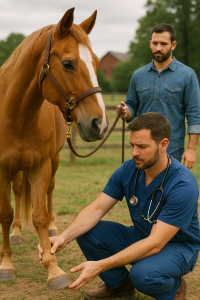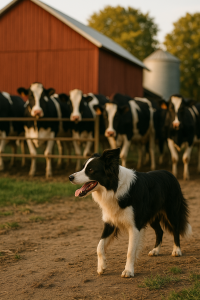
If you’re reading this, you probably have this burning question: How do I keep working animals healthy and pain-free??
Health, performance, and longevity – these are the fundamental pillars that determine whether working animals can thrive in their demanding roles year after year.
From the service dogs guiding visually impaired individuals through busy streets to the police dogs protecting our communities, from therapy animals bringing comfort to those in need to the farm animals supporting our agricultural systems – working animals are integral to countless aspects of our daily lives.

Yet as these incredible animals dedicate themselves to serving us, one question becomes paramount: How do we ensure they remain healthy, pain-free, and capable of performing their vital work throughout their careers?
Research consistently shows that the right approach to animal care can dramatically extend both the working life and quality of life for these dedicated animals.
So if you’re caring for working animals, or thinking about it, you’re probably wondering: How do I make sure they stay healthy and pain-free? How do I know if they’re struggling? And what can I do to help them have long, successful working careers?
That’s exactly what we’re going to talk about. We’ll cover everything from spotting early warning signs to some pretty cool new wellness techniques that are making a real difference.
Sound good? Let’s jump in.
Understanding The Reality of Working Animals
Working animals are in a completely different league than regular pets. And I mean that in the best way possible.
Think about what they actually do. A service dog isn’t just walking around the neighborhood – they’re constantly scanning for dangers, navigating crowds, and making split-second decisions to keep their handler safe. Police dogs go from zero to hero in seconds, then back to calm and controlled. Farm animals? They’re out there doing physical labor that would exhaust most of us.
The thing is, these animals love their jobs. But their bodies take a beating that most house pets never experience.
Here’s what research tells us happens: Working animals develop the same kinds of issues that human athletes do. Repetitive stress injuries from doing the same movements over and over. Joint problems from carrying heavy loads. Muscle strain from intense activity. And sometimes they just plain get worn out.
The only difference is, they can’t tell us about it. Your dog isn’t going to come up to you and say, “Hey, my shoulder’s been bothering me lately, maybe we should take it easy today.”
So we have to be the ones watching for signs and staying ahead of problems before they get serious.
The Foundation: Essential Health Management Practices For Working Animals.
When it comes to keeping working animals healthy and productive, success lies in building a solid foundation of consistent, proactive care practices.
Think of it this way: just as a well-maintained machine performs better and lasts longer, working animals thrive when their basic health needs are consistently met at the highest standard.
1. Nutrition and hydration as performance fuel
Working animals have significantly higher nutritional requirements than their companion animal counterparts. Their bodies are constantly repairing muscle tissue, maintaining energy reserves, and supporting heightened immune function.
A species-specific, balanced diet becomes absolutely critical – not just for basic health, but for optimal performance and recovery. The nutritional needs of a search and rescue dog working in mountainous terrain are vastly different from those of a therapy horse providing gentle rides to children with disabilities.
Hydration deserves special attention because working animals often perform in conditions where their normal drinking patterns are disrupted. Dehydration not only affects immediate performance but can lead to serious health complications, particularly in hot weather or during intense physical activity.
2. Preventive veterinary care as your early warning system
Regular veterinary check-ups for working animals should be viewed as performance optimization sessions rather than just medical appointments. These examinations can detect subtle changes in condition, mobility, or behavior that might indicate developing problems.
The key here is consistency and thoroughness. Working animals benefit from more frequent health assessments than typical pets because the demands placed on their bodies create more opportunities for issues to develop.
Vaccinations, parasite prevention, and dental care form the basic framework, but working animals often need additional monitoring for joint health, cardiovascular condition, and stress-related issues.
3. Progressive training and conditioning protocols
Research in animal behavior and veterinary medicine shows that one of the biggest mistakes in working animal management is the assumption that because an animal is “working,” they’re automatically in peak condition. The reality is that proper conditioning requires the same systematic approach used for human athletes.
Building endurance and strength gradually prevents injuries and extends working careers. This means starting new animals slowly, incorporating variety in their training routines, and most importantly, building adequate recovery time into their schedules.
Rest periods aren’t just nice-to-have additions to a working animal’s routine – they’re essential for tissue repair, mental recovery, and long-term sustainability.
4. Environmental factors that impact long-term health
The living conditions for working animals directly affect their ability to recover from daily work demands and maintain optimal health over time.
Proper shelter that protects from weather extremes, clean and comfortable bedding that supports joint health, and safe spaces where animals can truly relax all contribute to their overall well-being and working longevity.
Weight management deserves special mention here because it affects every other aspect of health and performance. Working animals carrying excess weight face increased stress on joints, reduced cardiovascular efficiency, and higher injury risk.
How to Recognize and Manage Pain
Pain management in working animals presents unique challenges because these animals are often highly motivated to work despite discomfort, and their training may actually encourage them to push through pain signals.
This is where skilled observation becomes absolutely critical. Working animals can’t tell us when something hurts, but they communicate through subtle changes in behavior, movement patterns, and performance that trained handlers can learn to recognize.
Behavioral indicators often appear before physical symptoms
Changes in attitude, reluctance to perform previously enjoyed tasks, or unusual behaviors like increased irritability or withdrawal can all signal developing pain issues. These behavioral changes often precede obvious physical symptoms and represent our best opportunity for early intervention.
Physical signs require immediate attention
More obvious indicators like limping, swelling, abnormal postures, or guarding specific body parts represent situations where pain management should be addressed immediately. At this stage, continuing to work the animal without addressing the underlying issue can lead to chronic problems and potentially career-ending injuries.
Professional pain management strategies
When pain is suspected, veterinary consultation becomes essential. Modern veterinary medicine offers numerous options for pain management in working animals, from anti-inflammatory medications to targeted therapies that can address specific conditions.
The key is never attempting to manage pain without professional guidance. What works for one species or condition may be harmful to another, and working animals often require carefully balanced approaches that manage pain while maintaining their ability to work safely.
Therapeutic interventions that support recovery
Activities like controlled swimming, gentle stretching routines, and targeted exercises can play important roles in both pain management and injury prevention. These interventions work best when implemented under professional guidance and tailored to the specific animal and their work requirements.
Advanced Wellness – How To Take Your Care To The Next Level For Longevity
Supporting the long-term health and career longevity of working animals requires going beyond basic care to incorporate proactive wellness practices that optimize their physical condition and recovery capacity.
Massage and physical therapy as performance tools
Massage therapy for working animals isn’t a luxury – it’s a practical tool for maintaining muscle health, improving circulation, and identifying developing problems before they become serious issues.
Regular massage helps prevent muscle tension from building up, promotes faster recovery after intense work periods, and provides valuable opportunities for handlers to assess their animals’ physical condition through hands-on examination.
Physical therapy techniques, including targeted exercises and mobility work, can help maintain joint function, prevent stiffness, and address minor issues before they develop into major problems.
Exercise programming beyond work tasks
While working animals are active by definition, their work-related activities often involve repetitive movements that can lead to muscle imbalances and overuse injuries. Supplemental exercise programs help address these issues by promoting overall fitness and movement variety.
Low-impact activities like swimming provide excellent cardiovascular conditioning while reducing stress on joints. Controlled walking and varied terrain work can help maintain flexibility and coordination.
The key is designing exercise programs that complement rather than compete with work demands, providing fitness benefits while allowing adequate recovery time.
Innovative wellness technologies
Modern technology is opening new possibilities for supporting working animal health and performance. One particularly promising area is the application of Pulsed Electromagnetic Field (PEMF) therapy to animal wellness.
PEMF machines work by promoting optimal cellular function and supporting the body’s natural recovery processes. For working animals, this technology offers potential benefits including enhanced recovery times, improved joint comfort, sustained energy levels, and overall wellness support.
What makes PEMF therapy particularly interesting for working animals is that it’s completely non-invasive and supports the body’s own healing processes. This cell-energizing therapy can potentially help working animals maintain their performance while managing the physical stresses of their demanding roles.
If you’re curious about how PEMF therapy might work for your working animals, check out our detailed review of the Healthy Wave PEMF Mat for Dogs to see how this technology is being used specifically for canine wellness.
How You Can Take Care Of Working Animals – Your Step-by-Step Guide
If you’re responsible for the care of working animals, implementing these wellness strategies doesn’t have to be overwhelming. Here’s your step-by-step approach to building a comprehensive health management program:
Start with a baseline health assessment Work with your veterinarian to establish a complete picture of each animal’s current health status, including any existing issues or areas of concern that need monitoring.
Develop individualized care protocols Recognize that each working animal has unique needs based on their role, physical condition, age, and health history. What works for one animal may need modification for another.
Implement systematic observation practices Train yourself and others involved in animal care to recognize early signs of health issues, pain, or performance changes. Early detection is often the key to successful intervention.
Build recovery time into work schedules Ensure that rest and recovery receive the same priority as work tasks. Overworked animals are more prone to injury and have shorter working careers.
Explore advanced wellness options Consider incorporating technologies like PEMF therapy and professional services like massage therapy that can support your animals’ long-term health and performance.
Maintain detailed health records Documentation helps track patterns, identify developing issues, and communicate effectively with veterinary professionals about your animals’ health status.
The goal is creating a sustainable approach to working animal care that supports both immediate performance needs and long-term career longevity. These incredible animals give us their best every day – they deserve nothing less than our most thoughtful and comprehensive care in return.
By implementing these practices and staying committed to ongoing learning about animal health and wellness, we can keep working animals healthy while ensuring they not only perform their vital roles effectively but also enjoy long, fulfilling careers in service to humanity.
Curious to know what PEMF therapy can look like for your working animal?
Tap the button below to read a review of the Healthy Wave PEMF Mat For Dogs
Tap Here!


